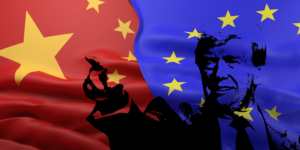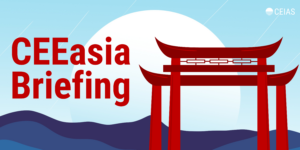Changing narratives around Chinese economic slowdown have sparked a renewed interest in Japan and India as an alternative source of economic growth and investment destinations. And while such arguments have resurfaced regularly in recent years, the overall strategic environment has changed markedly suggesting this time the outcome might be different.
Past several months have seen a rapid shift in the international media narrative surrounding the US-China competition. Gone seem to be the days where prevailing attitudes supported Kishore Mahbubani’s optimism of China’s economy becoming the world’s number one. Instead, political and economic commentators have been all engaging in predicting doomsday scenarios for China’s economy, not only triggering one of the major sell-offs of Chinese equities in decades earlier this year but market strategists now continuously recommending underweight positions on China.
At the back of this narrative, two countries are enjoying a spotlight as an alternative source of bullishness: Japan and India. For seasoned Asia watchers, this does not come as a big surprise. There is an established pattern of similar narratives surrounding these two countries re-emerging every few years; Japan as a sleeping giant whose return is only a question of time and India’s quiet rise with its growing population. It is then understandable to have a healthy amount of skepticism around the current optimism. However, at the second glance, the current environment and geopolitical realities surrounding these narratives seem to be unlike the past ones, raising the question whether there is more to this than meets the eye.
Japan: this time is different?
Hopes around Japan’s return to its economic glory have been resurfacing pretty much every few years over the past two decades. Following the market crash in 1989 and Global Financial Crisis in 2008, former Prime Minister Shinzo Abe elected in 2012 embarked on a major reform of the country’s economy dubbed as Abenomics. The most crucial part of his plan – improving corporate governance to reshape the stagnant economy – was nothing new, leading to a lot of skepticism about the real impact some of Abe’s policies will generate. However, it is maybe only now that we are finally seeing some of the reforms reaping success. Over the past year, institutional investors have become increasingly bullish when it comes to Japan. Likes of Warren Buffet have been betting heavily on Japan’s return. So is this time different?
Rather than the pure success of Abe’s reforms, most of Japan’s current success might be just simply being lucky. First, post-Covid-19 global economic environment has led to rising inflation in Japan. But unlike in the rest of the world, some investors and market commentators perceive inflation as being beneficial for the Japanese economy that had been stuck in a deflationary cycle until now. This has been particularly evident in the highest pay increase in 32 years agreed by Japanese companies this May, sparking hopes for a revival of the economy. However, more importantly, backing Japan is now becoming political. The current US administration has been increasingly pursuing its policy of backing Indo-Pacific, Japan and India including, as the major counterbalance to China. Over the past few months, this has been particularly evident in new initiatives and cooperation between Japan and the US in hi-tech sectors, including AI and investment in semiconductors. In addition, the EU’s relations with Japan have also improved; in May the two sides agreed to improve their cooperation on strengthening supply chains. Therefore, companies betting on Japan can now expect more benefits coming from such corporations, potentially seeking support from their respective governments when setting up operations in the country.
India: Countering the non-aligned movement
Similarly to Japan, narratives around India’s impending economic supremacy have been around for a while. Mainly based on India’s growing population that according to some estimates already overtook China as the most populous country last year, the growth potential of this economy is immense. In addition, India as an alternative destination for supply chain diversification has also become an increasingly prominent issue on the back of Covid-19 and rising competition with China in recent years. Arguments are simple, India has relatively cheap labor costs and so can compete with China as a manufacturing base.
There is also a strong argument for India being perceived as the world’s largest democracy. Although this can be disputed – and often is by many – backing India is also a strong political choice that sends a message to the world and challenges the increasingly local voices around the return of non-aligned movements amid US-China competition, particularly after India’s relatively muted response to Russia’s invasion of Ukraine in 2022. Most specifically, countries that are not aligned with either side but choose to stay neutral. In this way, support for India has an added layer of trying to bring this country closer to the US orbit of influence and encourage democratic governance and standards in the region as more Western capital pours in.
Limits to the rise: Yen’s curse & religious nationalism
There are still reasons to stay cautious when it comes to the current euphoria surrounding Japan and India, however. For starters, Japan’s weakening currency has been generating a lot of headaches in recent months, hitting multi-decade low last month. And despite this weakness being seemingly mainly generated due to the strong US dollar, it is emblematic of the country’s more serious issue that is its effort to shift away from monetary easing policy after more than a decade. The jury is still out on whether the authorities will be able to manage raising interest rates without negatively impacting economic growth. This is particularly as there are already signs of weakening yen negatively impacting local consumers.
In India, issues potentially hindering a country’s growth are more deep-seated. India’s bureaucratic red tape remains notorious with little improvement to this issue in the past few years. In addition, India is not China, meaning hopes around India becoming the alternative might be fundamentally misguided as they fail to account for cultural differences when it comes to work culture as well as challenges to local infrastructure whether it comes to transportation or reliable access to electricity. Lastly, the ongoing elections have nothing but further highlighted the worrying trend of rising Hindu-nationalism that can quickly spark tensions and lead to real cost for local companies.
With the US presidential elections approaching in November, a change of sentiment around China seems extremely unlikely. This means narratives around Japan and India are here to stay and will probably continue to generate more investment activity and foreign cooperation. However, it will probably take a few years for us to find out whether these can generate a real-world change and meaningful shift in strategic competition in wider Asia.







